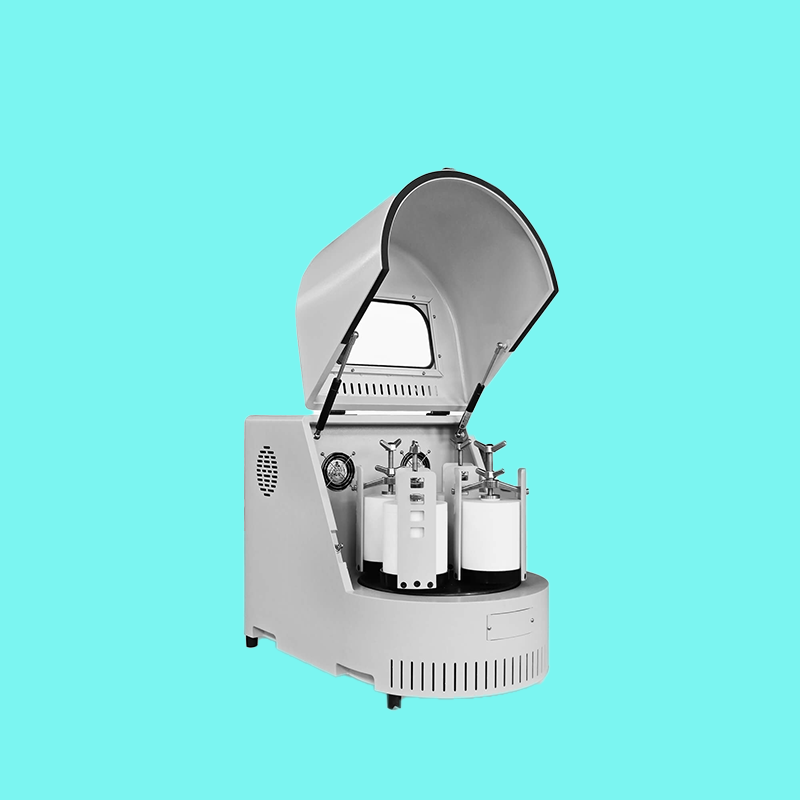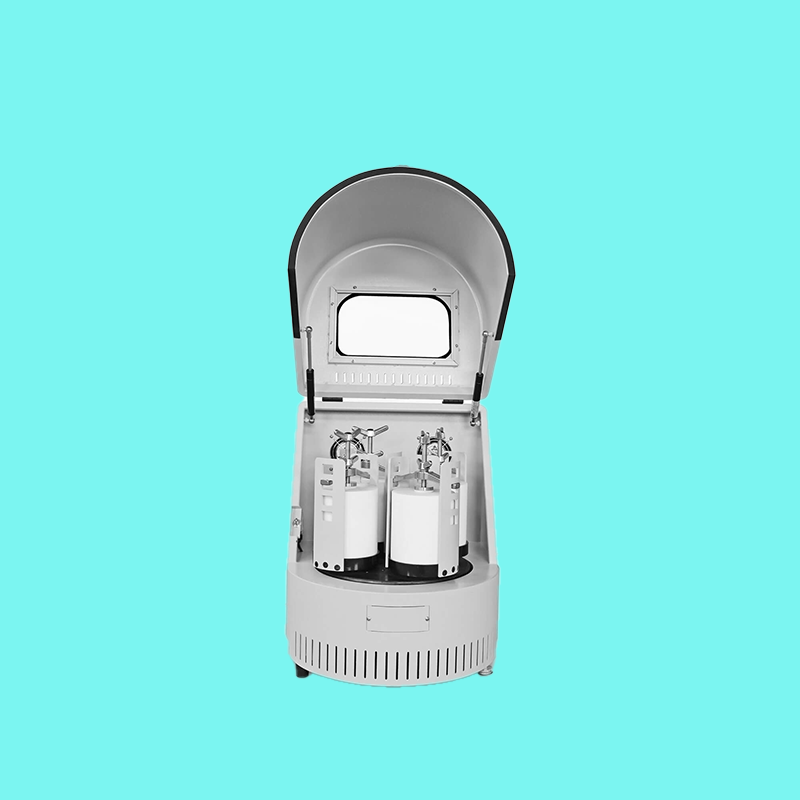The planetary ball mill mainly includes the ball mill body-grinding jar-grinding balls, etc.
The ball mill body mainly includes a planetary disk (a circular platform with a grinding jar on it), a motor, and a control system.
The motor drives the planetary disk to operate, and the control system controls the speed and frequency of the operation.
When the planetary disk is operating, the tank body rotates in the opposite direction with it as the axis.

The centrifugal force generated by the opposite rotation of the planetary disk and the tank body accelerates the grinding balls.
Due to the collision caused by the irregular movement of grinding balls of different sizes and grinding materials, the material placed in the grinding jar rubs against the grinding balls, achieving the effect of reducing the size of the ground material. This is the basic working principle of the planetary ball mill.
Generally, the operating speed of the planetary disk and the ball mill can maintain a 1:2 operating speed.
For example, the planetary disk (revolution) speed range: usually 50-450 rpm
The grinding jar (rotation) speed range: usually 100-900 rpm
It can also be fine-tuned through the dashboard or adjusted under the guidance of relevant technical personnel.
The influence of speed on grinding effect
1. Initial grinding stage: When starting to grind, the speed can be set higher to quickly smash the sample5.
2. During the grinding process: After grinding for a period of time (generally not more than 2 minutes), the speed can be reduced to improve the grinding efficiency and extend the service life of the equipment5.
3. The relationship between speed and grinding effect: high speed does not necessarily mean high efficiency. Reasonable speed, ball milling time, ball selection and other parameters are properly matched to achieve the best grinding effect.

Purpose and application fields of planetary ball mill:
1. Material science Used for grinding materials such as cemented carbide, ceramics, glass, metal, plastic, and the preparation of various functional materials such as electronic ceramics, structural ceramics, magnetic materials, catalysts, etc.
2. Geology and minerals In geological samples, ore analysis, soil sample preparation and heavy metal analysis
3. Agriculture and animal husbandry: used for soil sample processing and agricultural product quality analysis
4. Medicine: in ultrafine grinding of drug raw materials, catalyst preparation, etc.
5. Environmental protection: suitable for the preparation of environmentally friendly materials and waste treatment, such as grinding of materials required for treating wastewater and exhaust gas
6. Chemical and light industry: in the mixing and fine grinding of chemical raw materials, preparation of dyes and coatings, etc.
7. Electronics and information technology: used for the preparation of electronic components such as electronic ceramics, MLCC, thermistors
8. Nanotechnology: can grind materials with nanometer particle size
9. Scientific research and education (laboratory ball mill): as new material research and development, laboratory sample preparation
Currently, planetary ball mills are more widely used in industrial and mining enterprises, laboratories, soil samples, cemented carbide, ceramics, glass, metals, plastics, electronic ceramics, structural ceramics, magnetic materials, catalysts, drug raw materials, nanomaterials, chemical raw materials, dyes, coatings, etc.

Planetary ball mills can grind materials in two modes: dry and wet. Materials can also be divided into soft, hard, brittle and fiber.
For materials suitable for dry grinding, the volume of the material after grinding is relatively small. You can put 2/3 of the grinding balls and 1/3 of the material. During the dry grinding process, the planetary ball mill needs to pay attention to sealing and lubrication to reduce wear and dust pollution. At the same time, pay great attention to the thermal sensitivity and thermal stability of the material.
The advantage of wet grinding is that it can better protect and evenly disperse the material particles. During the grinding process, certain media such as water, glycerol, ethylene glycol, etc. can be added to the ball mill.
Note that the added medium cannot react chemically with the material to be ground or contaminate the material.
Because the volume of fiber materials will be reduced a lot after grinding, it is recommended to fill more materials when filling the materials to achieve the effect of fully grinding and protecting the grinding balls (please consult professional technicians for details).
If you are unclear about which type of ball mill equipment the material corresponds to, you can leave a message on our website and we will answer you as soon as possible.
For specific materials, please send us an email to request relevant information on what type and configuration of ball mill the material corresponds to.
Specifications of grinding jars and grinding balls
Capacity: The capacity of the grinding jar ranges from 0.4L to 1000ml, and the common capacities are 0.4L, 1L, 2L, 4L, etc.
Material: There are many choices of materials for the grinding jar, including stainless steel, zirconium oxide, agate, tungsten carbide, planetary corundum, nylon, polyurethane and polytetrafluoroethylene, etc.
There are also many choices for the specifications and materials of the grinding balls, as follows:
Size: Grinding balls come in a variety of sizes, small grinding balls are mainly used for grinding, and large grinding balls are mainly used for dispersion.
Material: The material of the grinding ball is usually stainless steel or other metal materials, and the specific material is selected according to the experimental requirements
Please choose different grinding jars and grinding balls according to specific needs
For example, if your material has high requirements for the material, and other metal impurities cannot be mixed during grinding, then stainless steel grinding jars and stainless steel grinding balls cannot be used, and zirconium oxide grinding jars and grinding balls can be selected.
If your material has high hardness requirements, it is recommended to use tungsten carbide ball mills and grinding balls;
For specific materials and corresponding ball mills and grinding balls, please contact us for advice!
Usage suggestions
When using a planetary ball mill, it is recommended to select appropriate grinding jars and grinding ball specifications according to experimental requirements. For example, for a 4-liter planetary ball mill, 2 or 4 ball mills can be placed, and the capacity of each ball mill can range from 50ml to 1000ml 23. In addition, the ratio of grinding balls to materials is also important. It is usually recommended that the grinding balls and materials reach two-thirds of the ball mill, leaving one-third of the space to prevent material overflow.
Finally, let's talk about the specific materials that can be ground by planetary ball mills in detail. If there are any deficiencies, please let us know and supplement them.
Call to Action (CTA)
Consult now for your exclusive guide
Email: tencan-ballmill@outlook.com
Whatsapp:8619974909729
Material Science
Metal powders (aluminum, iron, copper, titanium)
Alloy powders (nickel-based alloys, titanium alloys, stainless steel)
Ceramic powders (aluminum oxide, silicon carbide, silicon nitride)
Glass powders (borosilicate glass, quartz glass)
Carbon materials (graphite, carbon nanotubes, graphene)
Battery materials (lithium cobalt oxide, lithium iron phosphate)
Superconducting materials (yttrium barium copper oxide powder)
Geology and Minerals
Ores (quartz, feldspar, calcite)
Soil samples (for heavy metal analysis)
Volcanic ash
Rare earth minerals (monazite, bastnaesite )
Clay minerals (kaolin, montmorillonite)
Coal powder (for combustion or adsorption research)
Agriculture and animal husbandry
Plant tissues (dried roots, stems and leaves)
Grain powder (wheat, corn)
Animal bones (ground into bone meal)
Fertilizers (homogenized phosphate fertilizers and potash fertilizers)
Feed additives (shell powder, minerals)
Medicine
Traditional Chinese medicine (dried and ground into powder)
Active drug ingredients (API micronization)
Pharmaceutical excipients (lactose, microcrystalline cellulose)
Biological samples (freeze-dried bacteria or cells)
Dental materials (hydroxyapatite)
Environmental protection
Waste catalysts (recovery of precious metals)
Electronic waste (circuit board crushing)
Adsorption materials (activated carbon, boiling Stone)
Industrial sludge (heavy metal solidification pretreatment)
Tailing slag (resource utilization)
Chemical and light industry
Pigments (titanium dioxide, red iron oxide)
Dyes (azo dye ultrafine powder)
Plastic particles (PET, PVC pre-grinding)
Rubber powder (waste tire recycling)
Cosmetic raw materials (mica, talc)
Detergent ingredients (molecular sieve grinding)
Electronics and information technology
Magnetic materials (ferrite, neodymium iron boron)
Semiconductor materials (silicon powder, gallium arsenide)
Phosphor (rare earth phosphor for LED)
Piezoelectric materials (lead zirconate titanate PZT)
Conductive paste (silver powder, copper powder)
Nanotechnology
Nano oxides (nano titanium dioxide , nano zinc oxide)
Nanometallics (nano-gold, nano-silver)
Quantum dots (cadmium selenide, indium phosphide)
Nanocomposites (polymer-clay hybrid materials)
Scientific research and education
Standard reference materials (homogeneous preparation)
Teaching samples (mineral or alloy demonstration)
Archaeological materials (pottery, bone fossils)
Meteorite powder (astrochemical research)
Polymer gel (grinded after drying)
Bioceramics (β-tricalcium phosphate)
Magnetic fluid precursors
Solid electrolyte materials (LLZO)
Thermoelectric materials (bismuth telluride)
Precautions
Brittle materials (such as ceramics and ores) are easier to grind, while tough materials (such as plastics) need to be pre-frozen.
Some materials (such as flammable metals and organic matter) need to be ground in an inert gas or liquid medium.
In the pharmaceutical/food field, cross contamination should be avoided and special grinding jars should be used.
Planetary ball mills achieve micron/nano-level pulverization through high-energy collisions. The above materials can adjust the speed, time and grinding media (such as zirconium oxide balls, stainless steel balls) according to needs.

